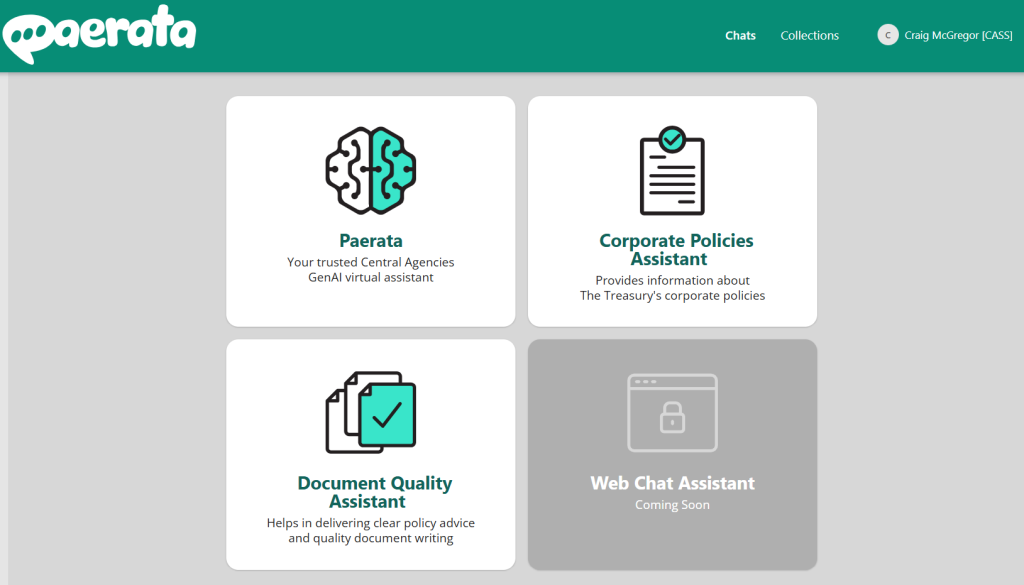Overview
Arinco partnered with The New Zealand Treasury to improve their generative AI capability and transform enterprise data management and accessibility. By deploying an AI-powered solution leveraging Arinco’s Coco AI accelerator and establishing a Microsoft Fabric-based data platform, these solutions have modernised and made AI, data integration and analytics accessible to all staff.
From enabling real-time feedback on policy drafts to surfacing insights from internal content, these solutions have improved decision-making, enhanced efficiency and laid a secure, scalable foundation for long-term innovation. The Corporate and Shared Services (CASS) team built internal capability through these projects and are now providing these solutions to their partner agencies.
About The Treasury and CASS
The Treasury is the New Zealand Government’s lead economic and financial advisor, responsible for managing the country’s finances and supporting long-term economic policy.
The Treasury’s Corporate and Shared Services (CASS) combines resources to provide sustainable corporate services including IT, information management, HR and finance to its partner agencies: the Department of the Prime Minister and Cabinet, and the National Emergency Management Agency.
Business challenge
CASS and its partner agencies were facing increasing complexity in how data and knowledge was managed and shared across teams. As volumes of structured data and unstructured content grew, so did the inconsistencies in how this information was accessed and used. Critical decisions, such as reviewing budget submissions, tracking project performance and workforce dynamics, were constrained by siloed systems, fragmented data sources and labour-intensive manual processes.
At the same time, the process of producing and reviewing unstructured content, such as policy documents, HR communications and internal guidance, relied on manual processes. Policy teams were expected to meet high standards for consistency, clarity and tone, but had lacked digital tools to support efficient drafting and review.
CASS saw an opportunity to address these challenges through a combination of data modernisation and applied AI. However, any solution needed to comply with New Zealand government’s strict security, privacy and data governance requirements. It also had to operate within the existing Microsoft ecosystem and be adaptable across a wide range of use cases. Finally, CASS wanted to ensure internal capability could be built up to independently manage and scale the platform over time.
An industry-leading data platform
To meet these goals, Arinco worked closely with CASS to deliver an end-to-end transformation with a secure data platform and enterprise-ready AI solutions.
Making AI and information accessible
Arinco and CASS co-developed “Paerata”, a secure generative AI chat assistant tailored to enhance transparency, accessibility and knowledge discovery from existing information assets. Specifically, this assistant includes:
- Document quality assistant – This tool provides real-time, context-aware feedback on tone, structure and clarity, aligning with internal guidelines and quality standards. This is intended to streamline the policy development and review processes, enabling human reviewers to focus on the quality of the analysis and document content.
- Corporate policies assistant – Designed to make internal guidance more accessible, this assistant allows staff to query corporate policies using natural language, making it easier than ever to find the information they need.
Arinco deployed and configured Coco, its customisable AI assistant platform to power these assistants. The solution surfaces insights from internal documentation and responds to natural language prompts within a secure, private interface. Arinco also provided software development guidance to enable CASS to adapt and modify the solution independently as “Paerata”.

Iterative delivery to drive adoption
The first AI use case, piloted with The Treasury, focused on improving the drafting and quality assurance process for policy documents. Arinco used an iterative delivery model, refining functionality based on hands-on feedback and running regular demonstrations to increase user confidence and engagement. This approach ensured the tool met real-world needs without disrupting existing processes.
Scaling out and use cases
Following the success of the pilot with The Treasury, the platform was extended CASS partner agencies to enable staff to access and interact with internal knowledge.
This solution empowered the government agency teams to ask questions and retrieve relevant information quickly, reducing time spent searching for policies, processes or past communications. It has now been extended to support a growing number of use cases across functions such as communications, with prompt libraries tailored to different team needs.
Secure and compliant by design
Given the sensitivity of government information, security and compliance were built into every layer of the solutions. The AI platform was configured to source only from approved, authoritative datasets and operated within a secure, private environment. Future integration with Bing will provide responses grounded from current public sources.
A modern enterprise data platform
To address the challenge of fragmented and siloed information, Arinco have also partnered with CASS to design and implement a secure and scalable enterprise data platform. Built using Microsoft Fabric and Azure Data Factory, the platform consolidated structured data from multiple sources, including Function Apps, REST APIs, SQL databases and blob storage. This centralised foundation enabled more efficient data management, consistent analytics and broader insights across government operations. In time, this will also be an important foundation as CASS scales its AI transformation.
The platform featured a source-controlled repository and automated deployment and orchestration pipelines, ensuring secure and repeatable development. The platform also aligns with the principles of Data as a Product and multi-layered data processing, creating a single source of truth for the whole organisation. Arinco ran a series of capability-building workshops covering data architecture, workspace structures, access controls and governance models. This ensured the CASS team could confidently operate and expand the platform, which now supports key use cases including government spending analysis, office space utilisation and workforce trend monitoring.
Building internal capability
Throughout both projects, Arinco worked closely with CASS to ensure knowledge transfer and long-term sustainability. As a result, CASS has since taken full ownership of the platform and is continuing to enhance and extend its functionality across departments. This growing in-house capability means the team can now develop and support new data and AI use cases independently, embedding data Insights and embedding AI to improve capability and productivity of our systems while maintaining safety and compliance.
Outcomes
This partnership demonstrated how a cohesive data and AI strategy can modernise government operations, bridging structured data and human knowledge to create tangible outcomes. Benefits to date include:
- Secure AI adoption, aligned to compliance frameworks and approved data sources.
- Improved productivity with AI digital assistance tools.
- Reduction in document preparation time, with greater efficiencies expected as adoption increases.
- Improved document quality, driven by with real-time AI feedback on tone, readability and structure.
- Fewer manual revisions, with early issue identification reducing review workloads.
- Shorter, more concise documents, supported by AI review tools.
- Wider accessibility, with persona-based prompts enabling broader team usage across HR, comms and policy.
- Enterprise-wide data framework adopted, with support for four end-to-end use cases.
- Source-controlled, automated data pipeline deployed for secure and scalable enterprise data platform operations.
- Ongoing innovation, with data and AI tools available in production, more business use cases are being identified and prioritised to develop future capabilities.





